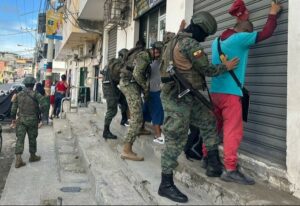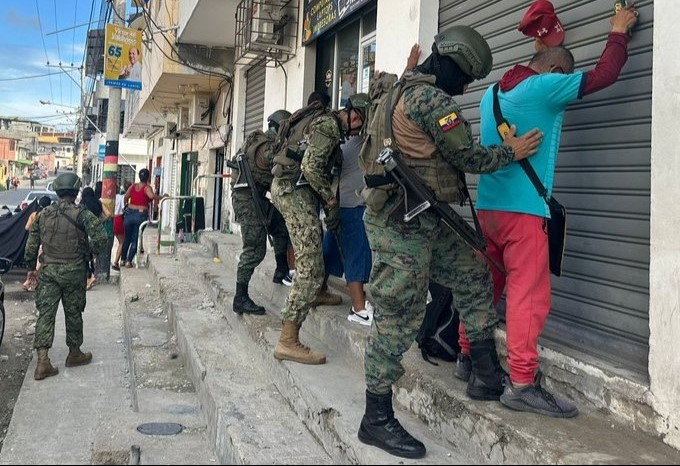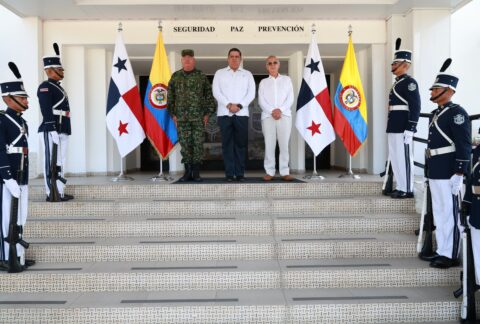The Sinaloa and Jalisco New Generation Mexican cartels are turning Ecuador into “a war zone” for control of cocaine trafficking from Colombia through Ecuador bound for the United States and Europe, U.S. digital platform Vice News reported.
Local gang members are sent to cartel-funded training camps in northern Ecuador to learn how to kill, narcotraffickers told Vice. Children are recruited as killers because under Ecuador’s legal system they face relatively little prison time if caught.
“The alarming violence, homicide rates, prison crises, and level of insecurity in Ecuador stem from the reconfiguration of cocaine trafficking routes [Europe and Asia-Pacific],” Yadira Gálvez, a security expert and academic at the National Autonomous University of Mexico, told Diálogo on May 12.
Ecuador’s homicide rate increased by 245 percent between 2020 and 2022, Vice reported. “If Ecuador was once a thoroughfare for cocaine, it’s now a superhighway,” the platform added.
“This is due to the reconfiguration of local and traditional criminal groups such as Los Choneros and Los Lobos, as well as the fragmentation and extensive involvement of Mexican cartels, not to mention Albanian criminal groups, institutional weakness, and corruption,” Gálvez said. “We can also point out […] the exported violence from Mexican organizations, exacerbated among criminal groups for the control of territories of narcotrafficking routes.”
Mexican cartels now call the shots by financing the cocaine production of Colombian guerrilla groups, Vice added. Meanwhile, Ecuadorian gangs are waging a proxy war on behalf of Mexican cartels, turning the country into Latin America’s “new killing fields.”
The unprecedented wave of violence in the Andean territory is impacting the daily lives of Ecuadorians and resulting in a massive exodus of people fleeing to the north of the continent, Mexican daily Reforma reported on March 12.
Expansion and adaptation
The violence is mainly recorded in Guayaquil and Esmeraldas. “Everyone knows who operates here. It is evident by the amount of drugs we are finding in the ports,” Ecuadorian National Police Major Fernando Estévez, who oversees drug inspections at the Port of Guayaquil, told Vice.

About 14,000 containers move through the Guayaquil Port each month. The inspection of containers falls to officers and 39 drug sniffing Belgian shepherds donated by the U.S. government. The canines can only reliably search three containers a day, Maj. Estévez said.
Meanwhile, Mexican cartels continue to innovate, getting better at concealing cocaine. A high-ranking Sinaloa Cartel chemist told Vice that the cartel has used industrial magnets to attach boxes of cocaine to the bottom of containers.
He noted that rivalries between the cartels erupted following the December 2020 assassination of an Ecuadorian known as Rasquiña, leader of Los Choneros, which controlled the country’s drug routes. Since then, the fights between gangs have not stopped.
“We are facing transnational, transregional networks, and organizations that adapt very quickly to the conditions we are living in,” said Gálvez. According to Ecuadorian daily Primicias, Ecuadorian authorities seized 673 tons of drugs between 2019 and March 2023.
“Mexican cartels are expanding not only north but also south of the border and practically all over the world,” Derek Maltz, former chief of the U.S. Drug Enforcement Administration’s (DEA) Special Operations Division, told Vice. “They are moving […] to build their global enterprise.”
Accompanying strategy
To contain this threat, the city of Guayaquil has been under a state of emergency since April 1, which allows for the deployment of the military in the streets and the implementation of curfews. The coastal provinces of Santa Elena, Esmeraldas, and Los Rios are also in a state of emergency, AFP reported on May 1.
“States of emergency are extended if they are not accompanied by other types of measures that help strengthen institutions,” said Gálvez. “At this time it is justified if we consider the level of violence and the capabilities that these criminal organizations have.”
“Ecuador needs a strategy accompanied by a lot of international cooperation that includes working together with Peru, Colombia, Central America, the United States, plus the European side, to gradually attack the problem of these organizations,” Gálvez added. “In this sense, the U.S. knows the importance of cooperation.”
In 2022, Washington and Quito signed the United States-Ecuador Partnership Act, which supports economic and social development of the country, with emphasis on the budget for “Narcotics and International Law Enforcement.”
“What cases like Mexico or Colombia tell us is that we can foresee the actions of these criminal organizations. If a comprehensive strategy is not applied that gradually co-opts the different areas of these organizations, such as the financial area, what we will see is that sadly the levels of violence in Ecuador will continue,” Gálvez concluded.









